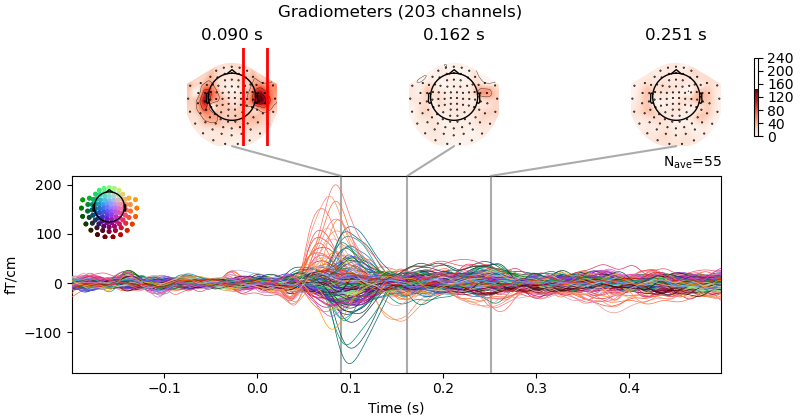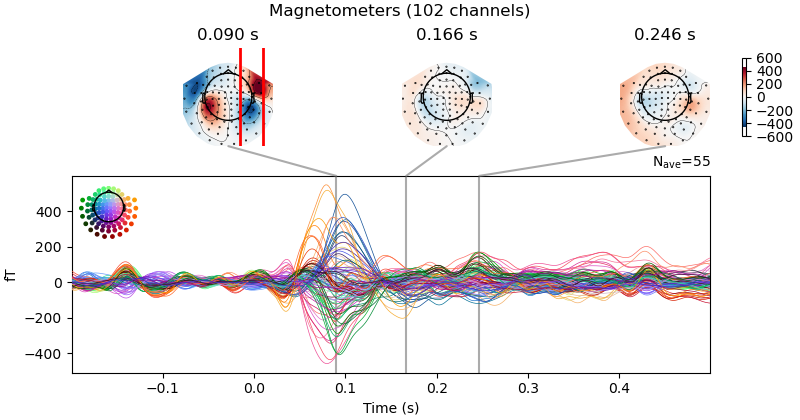Note
Go to the end to download the full example code. or to run this example in your browser via Binder
Compute SESAME inverse solution on evoked data in volume source space¶
In this example we shall compute SESAME inverse solution on evoked data in a volume source space. Data are taken from the MNE-Python sample dataset and correspond to the response to an auditory stimulus.
# Authors: Gianvittorio Luria <luria@dima.unige.it>
# Sara Sommariva <sommariva@dima.unige.it>
# Alberto Sorrentino <sorrentino@dima.unige.it>
#
# License: BSD (3-clause)
# sphinx_gallery_thumbnail_number = 3
from os import path as op
import matplotlib.pyplot as plt
import numpy as np
from nilearn.plotting import plot_stat_map
from nilearn.image import index_img
from mne import read_forward_solution, pick_types_forward, read_evokeds, \
read_trans, head_to_mri
from mne.datasets import sample
from mne.label import _n_colors
from sesameeg.mne import prepare_sesame
import time
data_path = sample.data_path()
subject = 'sample'
subjects_dir = op.join(data_path, 'subjects')
fname_fwd = op.join(data_path, 'MEG', subject,
'sample_audvis-meg-vol-7-fwd.fif')
fname_trans = op.join(data_path, 'MEG', subject,
'sample_audvis_raw-trans.fif')
fname_t1 = op.join(data_path , 'subjects', subject, 'mri', 'T1.mgz')
fname_evoked = op.join(data_path, 'MEG', subject, 'sample_audvis-ave.fif')
Load the mri-to-head coordinates transformation matrix, the forward solution
 and the evoked data
and the evoked data  .
The forward solution also defines the employed brain discretization which, in this example,
comprises the whole brain volume.
.
The forward solution also defines the employed brain discretization which, in this example,
comprises the whole brain volume.
# Transformation matrix
trans = read_trans(fname_trans)
# Choose sensor type
meg_sensor_type = True # All meg sensors will be included
eeg_sensor_type = False
# Forward solution
fwd = read_forward_solution(fname_fwd, exclude='bads')
fwd = pick_types_forward(fwd, meg=meg_sensor_type, eeg=eeg_sensor_type, ref_meg=False)
# Evoked Data
condition = 'Left Auditory'
evoked = read_evokeds(fname_evoked, condition=condition, baseline=(None, 0))
evoked = evoked.pick('meg', exclude='bads')
Reading forward solution from /home/pasca/mne_data/MNE-sample-data/MEG/sample/sample_audvis-meg-vol-7-fwd.fif...
Reading a source space...
[done]
1 source spaces read
Desired named matrix (kind = 3523 (FIFF_MNE_FORWARD_SOLUTION_GRAD)) not available
Read MEG forward solution (3757 sources, 306 channels, free orientations)
Source spaces transformed to the forward solution coordinate frame
305 out of 306 channels remain after picking
305 out of 305 channels remain after picking
Reading /home/pasca/mne_data/MNE-sample-data/MEG/sample/sample_audvis-ave.fif ...
Read a total of 4 projection items:
PCA-v1 (1 x 102) active
PCA-v2 (1 x 102) active
PCA-v3 (1 x 102) active
Average EEG reference (1 x 60) active
Found the data of interest:
t = -199.80 ... 499.49 ms (Left Auditory)
0 CTF compensation matrices available
nave = 55 - aspect type = 100
Projections have already been applied. Setting proj attribute to True.
Applying baseline correction (mode: mean)
Define the parameters.
time_min, time_max = 0.045, 0.135 # Select N100m
subsample = None
sample_min, sample_max = evoked.time_as_index([time_min, time_max], use_rounding=True)
# To accelerate the run time of this example, we use a small number of
# particles. We recall that the parameter ``n_parts`` represents, roughly speaking,
# the number of candidate solutions that are tested in the Monte Carlo procedure;
# larger values yield in principle more accurate reconstructions but also entail a
# higher computational cost. Setting the value to about a hundred seems to represent
# a good trade–off.
n_parts = 10
# If None, noise_std and dip_mom_std will be estimated by SESAME.
noise_std = None
dip_mom_std = None
noise_cov = None
# You can make SESAME pre-whiten the data by providing a noise covariance
# from mne import read_cov
# fname_cov = op.join(sample.data_path(), 'MEG', subject,
# 'sample_audvis-cov.fif')
# noise_cov = read_cov(fname_cov)
Visualize the selected data.
Projections have already been applied. Setting proj attribute to True.
Apply SESAME.
_sesame = prepare_sesame(fwd, evoked, n_parts=n_parts, noise_std=noise_std,
top_min=time_min, top_max=time_max, dip_mom_std=dip_mom_std,
hyper_q=True, noise_cov=noise_cov, subsample=subsample,
subject=subject, subjects_dir=subjects_dir, trans_matrix=trans)
time_start = time.time()
_sesame.apply_sesame()
time_elapsed = (time.time() - time_start)
print(f' Total computation time: {round(time_elapsed, 2)} seconds.')
# Compute goodness of fit
gof = _sesame.goodness_of_fit()
print(' Goodness of fit with the recorded data: {0}%'.format(round(gof, 4) * 100))
Computing inverse operator with 305 channels.
305 out of 305 channels remain after picking
Forward model with free source orientation.
Computing neighbours matrix [done]
Computing neighbours probabilities...[done]
Analyzing data from 0.045 s to 0.1349 s
Estimating dipole moment std...[done]
Estimated dipole moment std: 3.5816e-08
Sampling hyperprior for dipole moment std.
Estimating noise std...[done]
Estimated noise std: 3.9983e-12
Computing inverse solution. This will take a while...
Estimated dipole strength variance: 2.6413825716435953e-08
Estimated number of sources: 2
Estimated source locations:
* source 1: [-0.06009 0.00132211 0.0562192 ]
* source 2: [0.05158217 0.00683185 0.06580936]
[done in 97 iterations]
Total computation time: 12.31 seconds.
Goodness of fit with the recorded data: 68.69%
Visualize the posterior map of the dipoles’ location
 as an overlay onto the MRI.
as an overlay onto the MRI.
_sesame.plot_sources(plot_kwargs={'distance': 650})

Volume stc computed
WARNING! Removing invalid plot_stat_map keyword : distance
Visualize amplitude of the estimated sources as function of time.

Save results.
# You can save SESAME result in an HDF5 file with:
# _sesame.save_h5(save_fname, sbj=subject, data_path=fname_evoked, fwd_path=fname_fwd)
# You can save SESAME result in a Pickle file with:
# _sesame.save_pkl(save_fname, sbj=subject, data_path=fname_evoked, fwd_path=fname_fwd)
Total running time of the script: (0 minutes 19.629 seconds)

